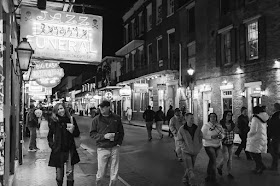 |
| Image in the style of William Eggleston (click to enlarge) |
Second, this has been an interesting exercise in self-examination, motivation, satisfaction and accomplishment. It is not an easy exercise, but in the end, I think worthwhile. I have spent a lot of time thinking about how to move my photography forward. I have found that when looking for change, a level of discomfort is introduced. But that is normal.
I think one answer to my photographic doldrums, dilemma, stagnation, malaise is for me to adopt a project. I've adopted projects in the past, such as those which can be found on my website, here, here and here. Those projects, however, have only been an extension of what I had been photographing all along. No, a new, long term project must be different from any previous projects. It must be something that will hold my interest long term, something that is meaningful to me and potentially to others, something visually different. I need the project to cause me to learn new ways of seeing and thinking. The project should be kind of like when you go to a new job; you have to learn new ways of doing things. This project can be in color or black and white. It doesn't matter, I don't think. Format won't matter as well.
Since the beginning of my photographic life, I've been a photographer of things; Earth, sky, water, land, man made objects, landscapes, nature, wildlife, beauty, beautiful natural colors, juxtapositions, contrasts, color, repetitive shapes, etc. I could go on. But the one theme that runs through all of my photography is that I am a photographer of things, albeit interesting things. One thought that I've had is that I should try to try the opposite. I should try to be a photographer of people as a project. Or maybe uninteresting, common, banal, ordinary things—trying to make something out of the mundane. In either case, such a project will require a completely different way of seeing. Visually, as well as style of working, it would be the opposite of what I've always done. That is attractive to me. It should be difficult and allow me to grow photographically.
 |
| Another in the style of Eggleston (click to enlarge) |
In the spirit of the above thought, there are two photographers that I find fascinating. You will be surprised by this when I name the photographers. I don't completely understand their vision (one of the reasons I find their work fascinating), but nonetheless, I have been fascinated with each's work for several years and for completely different reasons. I have been learning more about each's vision for some time.
The two photographers, who could not be more different in their work, way of working, vision and resulting images (from each other as well as from mine), are Gary Winogrand and William Eggleston. If you are not familiar with these two, this post will mean more to you if you read a bit about them and look at their work. I've collected books by both.
As different as they both are, what I believe they have in common, and it is something that has always pulled at me, is making sense out of chaos. In essence, I did that for a living as a law enforcement officer and chief of police for over 30 years. Winogrand takes chaotic momentary scenes involving people and manages to create order and interest. Eggleston takes the chaos of everyday, overlooked ordinary found items, and sees them in some sort of visual order and meaning within the frame. Both have a talent for discovering people/things hiding in plain sight. They see goings on right in front of us that almost everyone ignores. Fascinating in how they can see this. They are much alike but at the same time completely different.
 |
| Finally a third in the style of Eggleston (click to enlarge) |
I think a drastic switching of photographic genre and gears is something that can shake up my vision, change the way I see the world and make me really work hard to create something that is not just random. If I were to attempt to photograph in the style of either one of these noted photographers, there is no way that I could ever approach the mastery of their vision. No, I would be merely an apprentice trying to create and hone my vision toward people going about their everyday lives or trying to recognize significance in everyday objects and commonplace scenes. The challenge, of course, is to see visual and contextual interest and capture it. If I adopt one of these two potential projects, this will be a huge challenge for me as I have always been a photographer of things and things of beauty. With things, I can pretty much control everything about my subject. With people and the ordinary, I have no control whatsoever. I have to take what I get.
If I were to adopt a project in the style of Winogrand, I think I have the perfect camera for it. The E-M1 Mark II, with its small unobtrusive size, fast lenses, pre-programmed settings (C1, C2, C3) and the ability to use the LCD to touch anywhere, instantly focus, then expose the scene would work very well. I imagine walking around with the camera and when something appears, raise the camera in front of me, touch the LCD at the point of where I want the focus to be and the exposure is made. Quick, accurate and almost unnoticed.
 |
| Winogrand style image (click to enlarge) |
Of course, either camera could work for either project, I just think each as strengths the other doesn't have that would make one better for one project and the other better for the other project.
So there you have one answer. I will probably continue with some of my "normal" photography, even though I don't find it very challenging anymore, but I'm going to try hard to keep a camera in my right hand whenever I go out so it is at the ready when I see something that is of interest. In addition, I'll keep mulling this question about something needing to change and maybe come up with a definitive answer and more introspection. After all, this is all about stretching, exploring, growing, reaching, becoming uncomfortable and finally being a better photographer.
Also, I expect to fail much more often than I succeed. That has been my history and the history of most of us. (What is the saying? "It is not how many times you are knocked down but how many times you get back up." That is probably a paraphrase.) But I don't like failure. I know I will try really hard to succeed. I'll bring this subject back sometime in the future with an update to tell you where I am with it. In the mean time, I'll keep thinking and writing about photography then share with all of you.
 |
| Another in the style of Winogrand (click to enlarge) |
One last thing—these images I have posted here "in the style of" either Eggleston or Winogrand, are probably a poor representation of their styles. I'll admit that but I was looking for some images files that were of ordinary things and of people interacting in interesting ways. Hold the criticism of my feeble attempt, please! LOL
Thanks for looking. Enjoy!
Dennis A. Mook
All content on this blog is © 2013-2017 Dennis A. Mook. All Rights Reserved. Feel free to point to this blog from your website with full attribution. Permission may be granted for commercial use. Please contact Mr. Mook to discuss permission to reproduce the blog posts and/or images.
Thank you Dennis. You have a way of analyzing your situation and putting solutions out there in a way that many of us can relate to. I personally have let my photography dwindle to almost no activity due to lack of motivation. With your insight I hope to take a fresh look at my problem and adjust my mindset to recreate that drive that was there in the beginning.
ReplyDeleteThanks in advance, John E.
John, thank you for your comment and sharing your common experience.
DeleteI find that if I need to clarify things for myself, that if I write down my thoughts and try to construct a logical argument, I am much more successful than just mentally thinking through a problem or acting immediately. Writing down initial thoughts, putting those aside, then coming back to them several times over a period of days usually will allow me to thoroughly touch on all aspects of the issue. Many years ago I learned that my brain doesn't do well with snap decisions or quick answers. My brain likes to process thoughts over several days to arrive at a best answer.
Good luck. I know you will be back with passion soon!
Dennis, I read and replied to your first entry on this topic. What you are trying to take on and explore really resonates with me. Over my years of interest in making and viewing photographic images I share your sense of these (and other) photographers' shared ability to find and convey that sense out of seeming chaos. Not to get too woo woo about it, but maybe what the chaos has is that dynamic yin-yang balance and that's what the photographer feels and captures. I had a photography instructor many years ago whose personal work focused on these seemingly mundane shots of abandoned lots in towns with overgrown weeds, garbage and such. He'd print them huge - 3 x 5' and up. He found balance and complementarity and order just like in a composed still life. Imagine ourselves, the humans that populate a scene, as moving into at times that odd harmonious balance and complementarity, and what it can suggest as to the order and intent that is innate in their actions. Anyway, i'm rambling. But I really really appreciate you sharing this effort your taking on as it really resonates with my own photo interests. Hope you keep at it and share updates. Craig
ReplyDeleteI figured I'm not the only person who sometimes struggles with motivation and direction. I'm glad you were able to identify with my plight. In the end, I don't think I'll give up photographing those things I love, like the beauty of nature, but I'm also going to try to train my eye to see and make order from chaotic scenes. Now, as I go about my business, I find it difficult to do so but I'm hoping, with practice, seeing differently will become second nature.
Delete